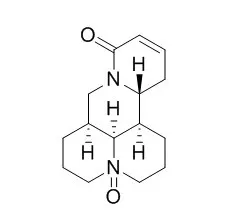| Kinase Assay: |
| Fitoterapia. 2015 Jun 2;105:26-36. | | Human microsomal cyttrochrome P450-mediated reduction of oxysophocarpine, an active and highly toxic constituent derived from Sophora flavescens species, and its intestinal absorption and metabolism in rat.[Pubmed: 26045316] | Oxysophocarpine (OSC), an active and toxic quinolizidine alkaloid, is highly valued in Sophora flavescens Ait. and Subprostrate sophora Root. OSC is used to treat inflammation and hepatitis for thousands of years in China.
METHODS AND RESULTS:
This study aims to investigate the CYP450-mediated reduction responsible for metabolizing OSC and to evaluate the absorption and metabolism of OSC in rat in situ. Four metabolites were identified, with sophocarpine (SC) as the major metabolite. SC formation was rapid in human and rat liver microsomes (HLMs and RLMs, respectively). The reduction rates in the liver are two fold higher than in the intestine, both in humans and rats. In HLMs, inhibitors of CYP2C9, 3A4/5, 2D6, and 2B6 had strong inhibitory effects on SC formation. Meanwhile, inhibitors of CYP3A and CYP2D6 had significant inhibition on SC formation in RLMs. Human recombinant CYP3A4/5, 2B6, 2D6, and 2C9 contributed significantly to SC production. The permeability in rat intestine and the excretion rates of metabolites were highest in the duodenum (p<0.05), and the absorbed amount of OSC in duodenum and jejunum was concentration-dependent. The metabolism could be significantly decreased by CYP3A inhibitor ketoconazole.
CONCLUSIONS:
In conclusion, the liver was the main organ responsible for OSC metabolism. First-pass metabolism via CYP3A4/5, 2B6, 2D6, and 2C9 may be the main reason for the poor OSC bioavailability. |
|
| Animal Research: |
| Cell Mol Neurobiol. 2017 Mar;37(2):339-349. | | The Anticonvulsant and Neuroprotective Effects of Oxysophocarpine on Pilocarpine-Induced Convulsions in Adult Male Mice.[Pubmed: 27481234] | Epilepsy is one of the prevalent and major neurological disorders, and approximately one-third of the individuals with epilepsy experience seizures that do not respond well to available medications.
METHODS AND RESULTS:
We investigated whether Oxysophocarpine (OSC) had anticonvulsant and neuroprotective property in the pilocarpine (PILO)-treated mice. Thirty minutes prior to the PILO injection, the mice were administrated with OSC (20, 40, and 80 mg/kg) once. Seizures and electroencephalography (EEG) were observed, and then the mice were killed for Nissl and Fluoro-jade B (FJB) staining. The oxidative stress was measured at 24 h after convulsion. Western blot analysis was used to examine the expressions of the Bax, Bcl-2, and Caspase-3. In this study, we found that pretreatment with OSC (40, 80 mg/kg) significantly delayed the onset of the first convulsion and status epilepticus (SE) and reduced the incidence of SE and mortality. Analysis of EEG recordings revealed that OSC (40, 80 mg/kg) significantly reduced epileptiform discharges. Furthermore, Nissl and FJB staining showed that OSC (40, 80 mg/kg) attenuated the neuronal cell loss and degeneration in hippocampus. In addition, OSC (40, 80 mg/kg) attenuated the changes in the levels of Malondialdehyde (MDA) and strengthened glutathione peroxidase and catalase activity in the hippocampus. Western blot analysis showed that OSC (40, 80 mg/kg) significantly decreased the expressions of Bax, Caspase-3 and increased the expression of Bcl-2.
CONCLUSIONS:
Collectively, the findings of this study indicated that OSC exerted anticonvulsant and neuroprotective effects on PILO-treated mice. The beneficial effects should encourage further studies to investigate OSC as an adjuvant in epilepsy, both to prevent seizures and to protect neurons in brain. |
|






 Cell. 2018 Jan 11;172(1-2):249-261.e12. doi: 10.1016/j.cell.2017.12.019.IF=36.216(2019)
Cell. 2018 Jan 11;172(1-2):249-261.e12. doi: 10.1016/j.cell.2017.12.019.IF=36.216(2019) Cell Metab. 2020 Mar 3;31(3):534-548.e5. doi: 10.1016/j.cmet.2020.01.002.IF=22.415(2019)
Cell Metab. 2020 Mar 3;31(3):534-548.e5. doi: 10.1016/j.cmet.2020.01.002.IF=22.415(2019) Mol Cell. 2017 Nov 16;68(4):673-685.e6. doi: 10.1016/j.molcel.2017.10.022.IF=14.548(2019)
Mol Cell. 2017 Nov 16;68(4):673-685.e6. doi: 10.1016/j.molcel.2017.10.022.IF=14.548(2019)